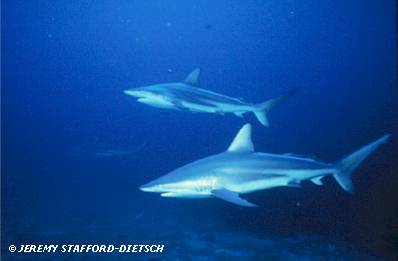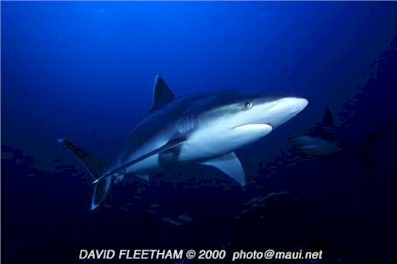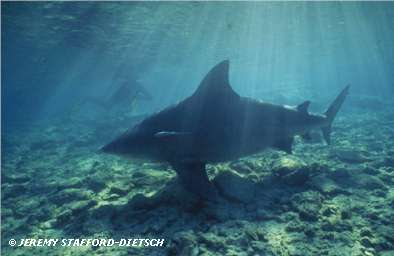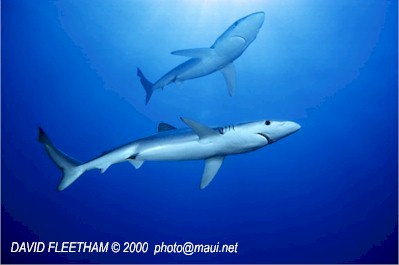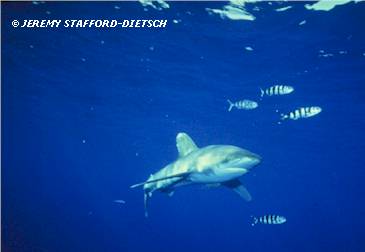Family Carcharhinidae:
Whaler Sharks — 54+ species
A typical carcharhinid, the Blacktip Shark (Carcharhinus [Aprionodon] limbatus) conforms to the popular conception of a 'typical' shark. In the Bahamas, divers often confuse this species with the similar Caribbean Reef Shark (C. perezi), from which it can readily be distinguished by its anal fins which are not black-tipped. Blacktip Sharks have been known to follow shrimp boats in the Gulf of Mexico, apparently lured by the hope that bycatch (which far out-weigh the targeted catch) will be discarded overboard.
Photo © Jeremy Stafford-Deitsch; used with the gracious permission of the photographer, who asks that you support the Shark Trust.
Thanks to wide exposure via television documentaries, one family of carcharhinoid has become our collective model of what a 'typical shark' looks like: the whaler or requiem sharks (family Carcharhinidae). The 57 or so species of carcharhinids are generally largish (most between 3 and 10 feet, or 1 and 3 metres, long), solidly-built sharks with few obvious distinguishing features, making it difficult to tell one species from another (among the cognoscente, they are often referred to as the "confusing carcharhinids"). Yet this family includes many of the most familiar sharks: blacktips, Blues, lemons, reef sharks, and the notorious Tiger Shark.
Photographed off Thailand's Burma Banks, this Silvertip Shark (Carcharhinus albimarginatus) is a solidly-built, typical carcharhinid. Found in the Indo-Pacific region, this species typically inhabits outer fore-reefs at depths of 80 feet (25 metres) or more.
Photo © David Fleetham david@davidfleetham.com; used with the gracious permission of the photographer.
 |
Nictitating Membrane of a Blacktip Shark (C. limbatus), showing membrane partially raised; (anterior of the shark is to the LEFT); the membrane itself is covered with fine dermal denticles. |
Tiger Shark (Galeocerdo cuvier)
Growing to a length of at least 18 feet (5.5 metres), the Tiger Shark (Galeocerdo cuvier) is the largest carcharhinoid and one of the very largest sharks. This species has a reputation as a "swimming garbage can" — just about every 'weird' object found inside a shark's stomach (chicken coops, drums, bottles of wine, unexploded munitions, rubber tires, and so on) came from a Tiger Shark. Given its large size, efficient cutting teeth and eclectic diet, it is hardy surprising that the Tiger Shark is known to occasionally extend its menu to include people and it should always be regarded as a dangerous wild animal (the Tiger Shark is second only to the Great White in the number of attacks on humans for which it has been indicted).
The Tiger Shark is usually placed in the family Carcharhinidae. However, it is a very unusual carcharhinid: it is much larger than any other species in that family, it has a unique slit-like spiracle behind the eyes, a unique upper labial furrow (lip groove), unique nostril flaps, unique cock's comb-shaped teeth that are similar in both jaws, and — perhaps most striking — it is the only member of that family that does not feature placental viviparity as its mode of embryonic nutrition (is is aplacentally viviparous or ovoviviparous). Several morphological and molecular genetic studies now strongly suggest that the Tiger Shark is not a basal carcharhinid but should be placed in its own family. For this purpose, I advocate the family Galeocerdidae. Time will tell whether this view will gain wide acceptance.
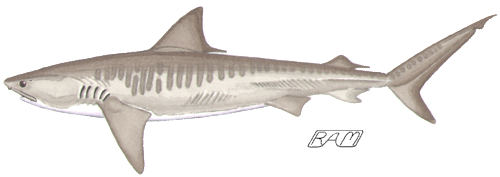
Full grown, the Tiger Shark (Galeocerdo cuvier) has little to fear from any predator that shares the tropical to warm temperate seas it inhabits. The same cannot be said of the newborns, which are 20 to 33 inches (51 to 86 centimetres) long and cute in a Derringer sort of way: large, powder blue eyes, over-sized head and fins, and elongated body with handsome spots. The caudal fin of neonate Tiger Sharks has a low thrust angle which precludes rapid swimming, so the pups employ an inefficient eel-like wriggle, making them vulnerable to predation until they outgrow this 'awkward stage' at about four years of age and 8 feet (2.5 metres) in length. Tiger Sharks are born on the bottom in coastal areas offering only moderate protection from predators. To minimize the risk of predation, the pups undergo very rapid linear growth — seeming to 'race' to attain a relatively safe body length of five feet (1.5 metres) within their first year of life. Despite this neat survival strategy, juvenile casualties are high; in order to ensure that at least a few pups survive to breed at an age of 7 or 8 years, Tiger Shark litters are very large — typically between 35 and 55 pups, but may consist of as many as 82. Even playing such numbers games, Tiger Sharks are relatively rare, clearly just able to replace losses incurred during early stages of their life history.
 The Tiger Shark (Galeocerdo
cuvier) is the biggest, weirdest carcharhinid. It grows to over
seven times as massive as any carcharhinid, has unique slit-like
spiracles, unique cockscomb-shaped teeth, and is the only member of the
family that is not placentally viviparous. Considering all these
peculiarities, I am very tempted to place this species is its own family,
Galeocerdidae.
The Tiger Shark (Galeocerdo
cuvier) is the biggest, weirdest carcharhinid. It grows to over
seven times as massive as any carcharhinid, has unique slit-like
spiracles, unique cockscomb-shaped teeth, and is the only member of the
family that is not placentally viviparous. Considering all these
peculiarities, I am very tempted to place this species is its own family,
Galeocerdidae.
Photo © Jeremy Stafford-Deitsch; used with the gracious permission of the photographer, who asks that you support the Shark Trust.
Bull Shark (Carcharhinus [Lamnarius] leucas)
The smaller but stockier Bull Shark (Carcharhinus [Lamnarius] leucas) is another dangerous species, most famous for its ability to penetrate far up freshwater rivers. It has been captured in freshwater rivers and lakes in Australia, New Guinea, the Philippines, Asia, Africa (where it has been known to attack young hippos), North, Central, and South America. Tagging studies in the 1960's and 1970's by Thomas Thorson and his co-workers have revealed that the Bull Shark readily swims between the Caribbean and Lake Nicaragua via the Rio San Juan, despite the churning rapids that were thought impassable and the tremendous osmotic changes between saltwater and fresh. Bull Sharks have also been captured off Alton, Illinois, 2,360 miles (3,800 kilometres) up the Mississippi River and in the foothills of the Peruvian Andes (surely one of the last places on Earth one would expect to find a shark), some 2,610 miles (4,200 kilometres) up the Amazon River.
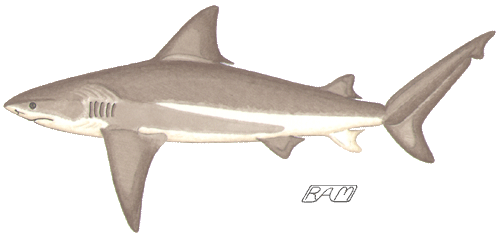
The
Bull Shark (Carcharhinus leucas) is a
solidly-built, typical carcharhinid. Although less spectacular than the Great
White, the Bull Shark is probably the most dangerous species of shark. It
combines large size, serrated teeth, heavily calcified jaws, a broad-spectrum
diet, and an unfortunate habit of living in coastal and river areas frequented
by people. The species is best known for penetrating far up freshwater rivers,
although it apparently does not complete its life cycle there. The Bull Shark
has a ferocious reputation as a man-eater, and almost everywhere it occurs it is
known by a different alias — including Zambezi Shark, Lake Nicaragua Shark, and
Ganges Shark (where it has been confused with and contributed toward the vicious
reputation of the 'true' Ganges Shark, Glyphis gangeticus). But — despite its
deceptively languid cruising pace — it is a large, heavily armed apex predator
that warrants extreme caution when encountered.
Although she looks more like a football with fins than a shark, this Bull Shark (Carcharhinus leucas) — photographed off Walker's Cay, Bahamas — may be pregnant. This heavy-bodied, heavily-armed species typically moves with a deceptive slowness, but should always be regarded as potentially very dangerous. The Bull Shark is probably responsible for more attacks on humans than any other shark.
Photo © Jeremy Stafford-Deitsch; used with the gracious permission of the photographer, who asks that you support the Shark Trust.
Blue Shark (Prionace glauca)
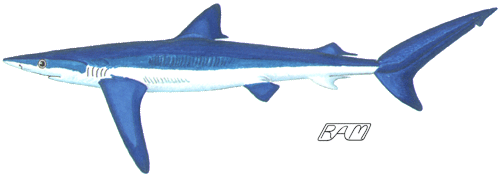
Blue Shark (Prionace glauca)
The graceful, elegantly sculpted Blue Shark (Prionace glauca) is an open-ocean glider. Tagging studies have revealed that blues regularly migrate across entire ocean basins, apparently conserving their energy stores by riding currents and gyres on their wing-like pectoral fins. Blue Shark migrations of 1,200 to 1,700 miles (2,000 to 3,000 kilometres) are common, and the record to date is a journey of 3,740 miles (5,980 kilometres) from New York to Brazil. Growing to a length of 12.5 feet (3.8 metres), the Blue Shark is one of only three open-ocean carcharhinoids (the other two being the Oceanic Whitetip (Carcharhinus [Galeolamna] longimanus) and the Silky Shark [Carcharhinus [Platypodon] falciformis), and it possesses a number of interesting adaptations to this vast habitat. Away from continental landmasses, food is scarce. The Blue Shark has large, sensitive eyes — the better to spot potential prey — and curious papillose (finger-like) gill-rakers that prevent krill, small squids and schooling fishes from escaping out the gill slits. In addition, the Blue Shark gives birth to very large numbers of young — commonly 25 to 50 pups per litter, but as many as 135 pups have been reported from a particularly fecund mother Blue — suggesting that the open ocean is a hazardous place for the 16-inch (40-centimetre) pups.
Blue Sharks (Prionace glauca) have large, staring eyes. Telemetering experiments in the North Atlantic have revealed this species often moves up and down in the water column, possibly as a way to increase the amount of open ocean it can scan visually for prey.
Photo © David Fleetham david@davidfleetham.com; used with the gracious permission of the photographer.
Silky Shark (Carcharhinus falciformis)
The Silky Shark (Carcharhinus falciformis) is not as fully adapted to the open ocean environment as is the Blue Shark (Prionace glauca), being often found closer to shore. The Silky is the shark species most often caught as bycatch in tropical eastern Pacific tuna fisheries and — as a consequence — its fins are often sold in the Asian sharkfin soup market and its jaws to tourists in shell and curio shops all over North America.
Photo © Jeremy Stafford-Deitsch; used with the gracious permission of the photographer, who asks that you support the Shark Trust.
Oceanic Whitetip Shark (Carcharhinus longimanus)
The Oceanic Whitetip Shark (Carcharhinus longimanus) has been called "The most numerous large animal on earth". Like many offshore sharks, this species is dangerously persistent, often charging repeatedly at divers or humans adrift in the open ocean. The Oceanic Whitetip is probably the species responsible for many of the shark casualties that occurred in the wake of the July 1945 torpedoing of the U.S.S. Indianapolis, immortalized by Quint's (played by Robert Shaw) wonderfully spooky monologue in the movie JAWS.
Photo © Jeremy Stafford-Deitsch; used with the gracious permission of the photographer, who asks that you support the Shark Trust.
Lemon Shark (Negaprion brevirostris)
Thanks to more than a decade of interdisciplinary field and laboratory studies co-ordinated by Samuel H. Gruber, the Lemon Shark (Negaprion brevirostris) has served as a model for the role of an apex predator in tropical marine ecosystems and is one of the most studied species of large shark. Much of Gruber's field work has been carried out in the shallow lagoons and surrounding deeper water of Bimini, in the Bahama Islands. At Bimini (once a favorite big-game fishing location for Ernest Hemingway) the entire life cycle of the Lemon shark can be studied, from birth and early growth to sexual maturity and reproduction.
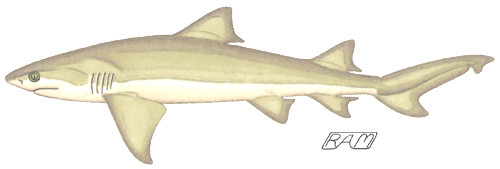
The Lemon Shark (Negaprion brevirostris) is one of the most studied and best understood of large sharks. The species has been particularly well investigated in a series of field studies co-ordinated by Samuel Gruber off Bimini, Bahamas, where it completes its entire life cycle in the warm, shallow lagoon and surrounding shelf waters. After a gestation period of 10 to 12 months, Lemon Shark pups are born between April and June in shallow nursery areas such as mangrove flats. They measure about 24 to 26 inches (60 to 65 centimetres) and number 4 to 19 (with 11 being the average); only about 20% of them will survive into their second year. The pups forage within a restricted space of only 3.7 to 5 square miles (6 to 8 square kilometres) on seagrass beds, lagoons, and other shallow areas, feeding primarily on small bony fishes (such as toadfish and pinfish) and shrimps. As the sharks grow to subadults, they gradually expand their range to about 190 square miles (300 square kilometres) — including offshore reefs and deeper waters — and begin taking larger fishes (sea catfishes, mullets, jacks, sting and eagle rays), as well as conchs, crabs, and seabirds. Sonic tagging indicates that this species is most active at dawn and dusk, increasing its daytime cruising speed from 0.9 miles (1.5 kilometres) per hour to 1.6 miles (2.5 kilometres) per hour. Female lemon sharks require about 15 years to reach sexual maturity at a length of about 8.5 feet (2.6 metres); males require roughly 13 years to reach maturity at a length of about 7.3 feet (2.2 metres). Courtship and mating occurs between April and May in shallows adjacent to nursery areas, beginning the cycle anew.
The carcharhinids have also provided glimpses into the surprisingly rich social behavior of sharks. Studies by Don Nelson and Richard Johnson on the Grey Reef Shark (Carcharhinus amblyrhynchos) have revealed highly predictable patterns of movement through well-defined home ranges and a stereotyped agonistic display when approached by other large sharks or humans.
